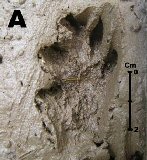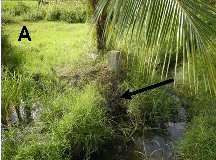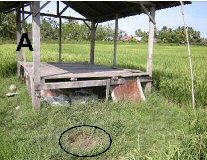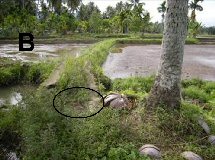IUCN/SSC Otter Specialist Group Bulletin

|
IUCN/SCC Otter Specialist Group Bulletin Volume 27 Issue 1 Pages 1 - 57 (January 2010) Citation: Aadrean, Salmah, S., Salsabila, A., Rizaldi and Janra, M.N. (2010). Tracks and Other Signs of Otters in Rice Fields in Padang Pariaman, West Sumatra: a Preliminary Study. IUCN Otter Spec. Group Bull. 27 (1): 6 – 11 Tracks and Other Signs of Otters in Rice Fields in Padang Pariaman, West Sumatra: a Preliminary Study Aadrean1, Siti Salmah1, Anas Salsabila2, Rizaldi1 and M. Nazri Janra1 1Department of Biology, Faculty of Science, Andalas University, Padang, Indonesia, e-mail : a2drean@gmail.com |




 |
Abstract: We identified otters based on tracks and other signs in a West Sumatran rice field. Field surveys were conducted from July to December 2008 at Padang Pariaman, West Sumatra, Indonesia. We identified one species, Aonyx cinereus (Illiger, 1815) based on the size and form of 8 fore and 17 hind footprints. Further, we describe three types of spraint site, sliding sites and other evidence of otter existence in this area. |
| Keywords: Species identification, footprint, rice field, sprainting site |
| Française | Español | Bahasa Indonesia |
INTRODUCTION
There are four species of otter in Sumatra, Lutra lutra, L. sumatrana, Lutrogale perspicillata, and Aonyx cinerea (Corbet and Hill, 1992). The first two species are protected by Indonesian law (Noerdjito and Maryanto, 2001). However, heavy use of pesticides in agriculture, the dumping of toxic wastes from factories, and domestic wastes and detergents from human settlements are contaminating many rivers and water systems in Indonesia, causing a severe threat to the entire aquatic food chain, including otters. In addition, the draining of wetlands in Sumatra and Kalimantan for agriculture and human settlement destroys important otter habitats and results in a decline in prey species (Foster-Turley and Santiapillai, 1990)
Rice fields, together with their contiguous aquatic habitats and dry land comprise a mosaic of rapidly changing ecotones that harbor a rich biological diversity. A variety of small mammal and fish species utilize rice fields, mainly as feeding sites. The concentration of prey species attracts medium-sized carnivorous mammals including otter (Bambaradeniya and Amerasinghe, 2003).
In Malaysia, Kerian rice fields are an important habitat for small-clawed and smooth otters. The brushy cover along the dikes and between separate rice fields serves as denning grounds for both otter species. Their survival in these areas depends on the availability of suitable prey and islands of brushy cover where they can den and raise cubs without human intervention (Foster-Turley, 1992)
In Indonesia, however, there is little information about the occurrence of otters in rice fields. Melisch, Asmoro, and. Kusumawardhami (1994) reported small-clawed otter existence in rice fields of West Java, however there is a of lack data from Sumatra. Otter existence is known from reports by local rice farmers and fishermen, with uncorroborated reports of otter species as pests. The objective of this study was to collect preliminary data on otter occurrence through tracks and other indirect signs. These data will be used as the basis for further investigation.
STUDY SITES AND METHODS
This study was located in the Lubuk Alung rice fields (between latitudes 0°38’27” and 0°40’34”S and longitudes 100°19’43” and 100°17’17”E), district of Padang Pariaman, West Sumatra (Figure 1)from July to December 2008. We conducted direct observation along rice field dikes and water canals. Lubuk Alung contains 3,804 Ha (hectares) of rice fields. Most fields (2,432 Ha) use technical irrigation with three harvests a year. Irrigation canals are also used for fish cultivation. We searched for otters’ track and other signs for a total of 21 days with three repeated surveys of 11.2Km along rice field dikes and water canals. We took pictures and measurements when encountering otter sign. Tracks were studied by collecting plaster casts, and were identified subsequently with reference to published literature on the basis of form and size (van Strien, 1983; Kruuk et al., 1994; Larivière 2003). Otter spraints were collected and stored for further research. Spraint sites, damage to paddy clumps, and sliding sites were recorded and described.
 |
| Figure 1. The study site in West Sumatra(click for larger version) |
RESULTS
TracksFootprints were found in mud bed near an irrigation line. A trail of parallel tracks from two individuals and randomized tracks were recorded. We found a total of 25 tracks from a single otter species, the small-clawed otter Aonyx cinereus (Illiger, 1985). Footprints of small-clawed otter are small with long fingers and incomplete webbing (Figure 2). Most tracks showed no indication of a claw mark. We found that fore feet were smaller than hind feet. Measurements (in mm) of 8 fore feet and 17 hind feet averaged (range in parentheses): length of fore feet, 56.06 (51.30-63.60); width of fore feet, 37.81 (29.55-47.95); length of hind feet, 67.47 (61.60-71.15); and width of hind feet, 51.63 (45.55-58.00). Measurements of 7 track trails (in mm) averaged: step, 159.14 (128-208); stride 380.85 (346-428), and straddle 115.71 (104-132). In addition to small-clawed otter tracks, tracks of Leopard cat (Felis bengalensis), domestic dog (Canis domesticus), domestic cattle (Bos indicus), water monitor (Varanus salvator) and some bird species were also found.
 |
 |
| Figure
2. Tracks
of small-clawed otter A: Right Fore Foot, B: Left Hind Foot (click for larger versions) |
|
Spraints and sprainting sites
All spraints were found on a clearing path near a small irrigation line. Three sprainting sites were observed: near a rice field hut (69.23%), tree trunk (23.08%), and at a division of an irrigation canal (15.38%) (n=13) (Figure 3). Spraints were scattered black mass when fresh. The size of 6 spraints averaged 249.68 mm (range: 73.1-450) in smearing diameter. Spraints contained undigested material such as scales, bone and skin (Figure 4), all this material remains unidentified. Three spraints were collected for further study.
Other signs
Other signs included sliding sites and damage to paddy clumps (Figure 5). The sliding site was found near a small canal. Otters seem to slide from a higher dike to the waters surface. During surveys we found that otters broke paddy clumps in the corner of a rice field and at the side of a dike near a small canal. All damage to paddy clumps was found near sprainting sites. Based on local information, otters often break paddy clumps before depositing spraints, but further study is needed to confirm this information.
 |
 |
| Figure
5.Other signs, A: sliding site (show by arrow),
B: damage to paddy clumps (click for larger versions) |
|
DISCUSSION
This study shows that small-clawed otter appear to be feeding in the area and supports the findings of Foster-Turley (1994) who described rice fields in Kerian Perak (Malaysia) as a habitat used by small-clawed otter. Based on the tracks (including a parallel set from 2 individuals) we suggest that at least one family of small-clawed otters is present. Only one species was found in this area, suggesting that other otter species may not be as tolerant of human activities, which may account for their rarity throughout Southeast Asia.
We found that tracks of small-clawed otter were larger than those recorded from populations in Thailand, but smaller than Lutra sumatrana (Kanchanasaka, 1998), Lutra lutra and Lutrogale perspicillata (Kruuk et al., 1993; Kruuk et al., 1994). Although sizes varied, the form of small-clawed otter tracks enables unambiguous identification. Larivière (2003) summarized that tracks from A. cinereus can be differentiated from tracks of other otters by smaller size, absence of claw marks, incomplete webbing between fingers and toes, longer middle digit compared with other digits, and relatively long fingers. The difference in sizes we found could be partially explained by the variation in size in different substrates, for example Mercier and Fried (2004) analyzed the tracks of captive otters and found a significant difference in measurements between substrates.
Previous studies about diet of small-clawed otter have demonstrated the preferred diet of this animal was crabs (Kruuk et al., 1994). But in general, no crab remains were found in spraints of small-clawed otter in this study. This can be explained by the absence / low densities of crabs in the study area (Aadrean pers. observ.). But additional research is required to provide a thorough analysis of diet and prey availability. According to Foster-Turley (1992), about half of the small-clawed otter toilet sites show signs of scat-smearing, a behavior often seen in captivity. The result of this study supported these findings where all spraints showed sign of scat-smearing.
Damage and destruction of paddy clumps indicate places where otters have been body-rubbing (rolling, or pressing their sides against the ground or vegetation), which also occurs in other otter species and is often associated with sprainting sites (Kruuk et al., 1993). It is one of the ways of scent marking, but also, many carnivores bite off and eat grass every so often, to 'scour' their stomach (Kruuk, pers. comm.). In our study area, the damage to paddy clumps caused by otters occurs at a low level that has no impact on rice production, but does generate a bad image for local farmers who may sub- sequentially regard otters as pests.
To ensure the conservation of small-clawed otter in rice fields, further information on their ecology, feeding habits and social dynamics in this habitat is still needed. Research priorities include: revealing diet compositions by scat analysis, and exploring prey availability in this area.
Acknowledgements - We would like to thank Wilson Novarino, Ardinis Arbain and Padma de Silva for their contribution by constructive comments. We also acknowledge valuable support from zoological museum of Andalas University and Idea Wild. IUCN Otter Specialist Group has given first author a great support by access to valuable literatures and papers as student member. The following individuals for their contribution of papers and their explanations: Hans Kruuk, Budsabong Kanchanasaka and Irwansyah Reza Lubis. The manuscript was improved by the constructive comments and grammatical revision from Darren Norris, and other people who cannot be mentioned personally.
REFERENCES
Bambaradeniya, C.N.B. and Amerasinghe,
F.P. (2003). Biodiversity associated with the rice
field agroecosystem in Asian countries: A brief review. Working Paper
63. International Water Management Institute. Colombo. Sri Lanka
Corbet, G.B. and Hill, J.E. (1992). The Mammals
of The Indomalayan Region, A Systematic Review. Natural History Museum
Publications. Oxford University Press. New York
Foster-Turley, P. and Santiapillai, C. (1990). Action
plan for Asian otters, pp. 52 – 63. In Foster-Turley,
P.A., Macdonald, S., Mason, C.F. (eds.). Otters: An Action
Plan for Their Conservation, IUCN, Gland, Switzerland.
Foster-Turley, P.A.
(1992). Conservation
aspects of the ecology of asian small-clawed and smooth otters on
the Malay Peninsula. IUCN Otter Spec. Group Bull. 7:
26-29.
Kanchanasaka, B. (1998). Tracks and other signs
of the hairy-nosed otter (Lutra sumatrana). Proc. VIIth
International Otter Colloquium, IUCN Otter Spec.
Group Bull. 19A: 157-159.
Kruuk, H., Kanchanasaka, B., O’Sullivan, S. and Wanghongsa,
S. (1993). Identification of tracks and
other signs of three species of otter, Lutra lutra, L. perspicillata and Aonyx
cinerea in Thailand. Nat. Hist. Siam. Soc. 41:
23-30.
Kruuk, H., Kanchanasaka, B., O’Sullivan, S. and Wanghongsa,
S. (1994). Niche separation in three sympatric otters Lutra
perspicillata, L. lutra and Aonyx cinerea in
Huai Kha Khaeng Thailand. Biol. Cons. 69:
115-120.
Larivière, S. (2003). Amblonyx cinereus.
Mammalian species. 720: 1-5.
Melisch, R., Asmoro, P.B. and Kusumawardhami, L. (1994). Major
steps taken towards otter conservation in Indonesia. IUCN
Otter Spec. Group Bull. 10:
21–24.
Mercier, L. and Fried, G. (2004). Preliminary study
of the tracks of captive otters (Lutra lutra) as a tool
for field research. IUCN Otter Spec. Group Bull. 21:
94 – 99.
Noerdjito, M. and I. Maryanto. (2001). Jenis-jenis
Hayati Yang Dilindungi Perundang-undangan Indonesia. Balitbang Zoologi
Puslitbang Biologi LIPI & The Nature Conservasi. Cibinong.
van Strien, N.J. (1983). Guide to the Tracks of
Mammals of Western Indonesia. School of Environmental Conservation
Management. CIAWI. Indonesia.
Résumé : Pistes et
autres Indices de Presence de la Loutre dans les Rizieres de Padiang
Pariaman, Ouest de Sumatra : Etude Preliminaire
Nous avons identifié la présence de loutres dans les
rizières à l'ouest de l'île de Sumatra à partir
de pistes et d'autres indices. Les enquêtes de terrain se sont
déroulées entre juillet et décembre 2008 dans
le district de Padang Pariaman (Indonésie). Nous avons détecté une
espèce, Aonyx cinereus (Illiger, 1815) grâce à la
taille et à la forme de 8 empreintes antérieures et
17 postérieures. Enfin, nous avons décrit trois types
de sites de marquage, des sites de glissades et d'autres preuves
de l'existence de la loutre sur cette zone.
Revenez au dessus
Resumen: Rastro
y otros Signos sobre la Presencia de Nutrias dn Campos de Arroz
dn Padang Pariaman al Este de Sumatra : Estudio Preliminar
Basados en rastros y otros signos se identificaron nutrias en un
campo de arroz al este de Sumatra. Estudios de campo se condujeron
desde Julio hasta Diciembre de 2008 en Padang Pariaman al este de
Sumatra, Indonesia. Una especie de nutria (Aonyx cinereus)
fue identificada (Illiger, 1815) con base en el tamaño y la
forma de 8 huellas delanteras y 17 traseras. Adicionalmente, se describieron
tres tipos de sitios de deposición, sitos de deslizamiento
y otras evidencias de la existencia de nutrias en el area.
Vuelva a la tapa
Ringkasan: Jejak Dan Tanda-Tanda
Keberadaan Berang-Berang Di Area Persawahan Kabupaten Padang Pariaman,
Sumatera Barat
Identifikasi jejak dan tanda-tanda keberadaan berang-berang di area persawahan
telah dilakukan sejak Juli sampai Desember 2008 di Padang Pariaman, Sumatera
Barat. Kami telah mengidentifikasi satu jenis berang-berang Aonyx
cinereus (Illiger, 1815) berdasarkan ukuran dan bentuk dari 8 jejak
kaki depan dan 17 jejak kaki belakang. Kami juga telah mendeskripsikan
tiga tipe lokasi kotoran, lokasi luncuran, dan bukti keberadaan lainnya
di area ini.
Kembali untuk tertinggi halaman



